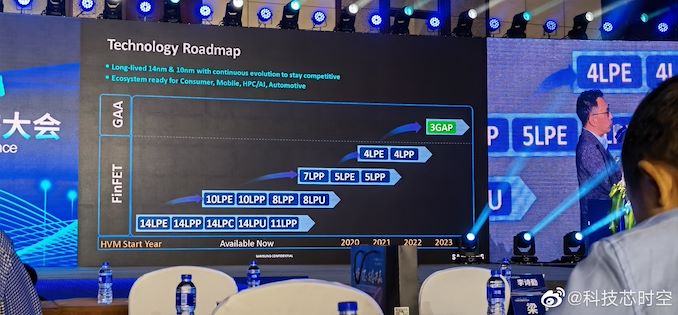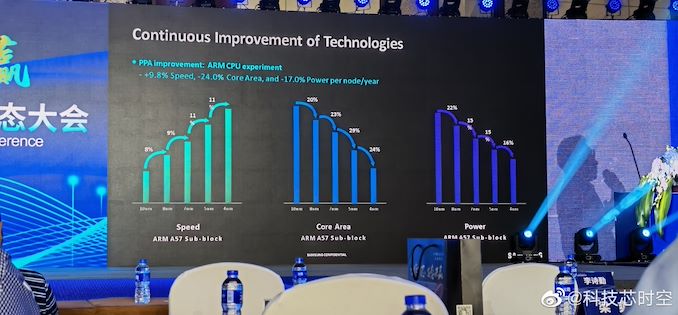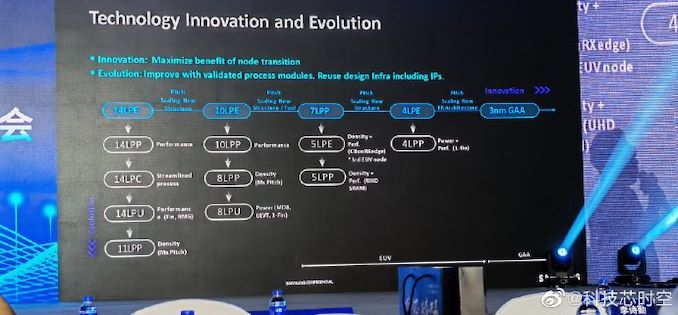Samsung: Deployment of 3nm GAE Node on Track for 2022
by Anton Shilov on July 9, 2021 1:20 PM ESTSamsung Foundry has made some changes to its plans concerning its 3 nm-class process technologies that use gate-all-around (GAA) transistors, or what Samsung calls its multi-bridge channel field-effect transistors (MBCFETs). Based on new information direct from Samsung, it would appear that its first version of 3nm, 3GAE (3nm gate-all-around early), is coming to high volume manufacturing a year later than expected, but also it seems to have removed this technology from its public roadmap, suggesting it may be for internal use only.
Meanwhile, 3GAE's successor 3GAP (3nm gate-all-around plus) node is still in the roadmap, it is on track for volume manufacturing in 2023.
3GAE on Track for 2022, Maybe Just Not for Everyone
At its recent 2021 IP & ASIC Design Ecosystem Conference in China, Samsung Foundry presented its updated public technology roadmap which was then republished by bloggers at Baidu and Weibo.
On its FinFET technologies, both 5LPP and 4LPP nodes are new to the roadmap, and set for high-volume manufacturing (HVM) in 2021 and 2022, respectively.
For GAA technology, 3GAE is absent from the roadmap, but 3GAP is there. We reached out to Samsung and a representative confirmed that the 3GAE technology is still on track for ramp in 2022. From the slide, we can see that MBCFET-based 3GAP will enter its HVM phase sometime in 2023.
"As for the 3GAE process, we've been in discussion with customers and expect to mass-produce 3GAE in 2022," the spokesperson said.
The absence of 3GAE process from the public roadmap may be explained by the fact that it will only be available to Samsung's own LSI division, just like some other (E)arly nodes. That being said, previous generation (E)arly nodes are still mentioned in the slides that the company demonstrated.
Samsung originally announced its MBCFET-based 3GAE and 3GAP nodes in May 2019. Back then, the company promised a 35% performance increase, a 50% power consumption reduction, and a 45% area reduction for 3GAE compared to 7LPP. Furthermore, the company announced the availability of v0.1 of its 3nm PDK and at the time said that volume production using 3GAE was set to start in late 2021. With that moving to 2022 based on the latest information, one might interpret this as either a delay or miscalculation based on enabling GAA designs at scale.
However on the plus side, Samsung taped out the first 3 nm test chip several weeks ago. It also announced the availability of Synopsys EDA tools compatible with the new fabrication technologies. The use of fabrication processes that rely on brand-new transistors is always a challenge - in addition to new electronic design automation (EDA) tools, chip developers need all-new IP. We look forward to hearing more disclosures on that front.
A New 4LPP Node on FinFETs
While it looks like general customers are not going to use Samsung's 3 nm nodes until 2023, the newly announced 4LPP is set to meet the requirements of the company's clients in 2022. Since 4LPP relies on familiar FinFETs, it will be much easier for Samsung's customers to use this node when compared to any 3nm GAA nodes early in their lifecycle.
It is noteworthy that Samsung now considers its 5 nm and 4 nm-class technologies as different node branches on its slides. Previously, the foundry considered its 4LPE as an evolution of its 7LPP process. Perhaps this is because 4 nm is set to offer very tangible PPAc (power, performance, area, cost) advantages over 5 nm, or because there are substantial internal changes (e.g., new materials, significantly higher usage of extreme ultraviolet lithography, etc.).
For example, one of Samsung's slides specifically mentions density and performance improvements for 5LPE and 5LPP, but only mentions power and performance improvements for 4LPP. The overlapping technologies will also help to mitigate risks if one of the nodes does not meet certain expectations.
Surprisingly, Samsung Foundry is set to ramp production using its 4LPE and 5LPP technologies at around the same time in 2021, which could enable it to offer different PPAc advantages for different chip designs.
Summary
While Samsung Foundry's GAAFET/MBCFET 3 nm plans appear to have changed and slipped by a year, it is unlikely a big problem for the company as its (E)arly nodes were never widely adopted. To cover that additional year, the company's new 5LPP and 4LPP FinFET-based technologies are set to enable PPA advantages for Samsung Foundry's clients and enable the company to gain more experience with EUV equipment before using it for its 3GAE/3GAP nodes.













32 Comments
View All Comments
movax2 - Monday, July 12, 2021 - link
the thing about Intel 10nm is that it runs hotter than TSMC 7nm. So, kinda not so real neither performant 10nm.FreckledTrout - Friday, July 16, 2021 - link
I like how you state that so matter of fact. There is nothing showing Intel's 10nm "runs hotter".sharath.naik - Friday, July 9, 2021 - link
They donot all measure the same way.. intel 10nm is closer to 7nm TSMC. I think samsung is a bit behind TSMC. But yes.. Intel like a lot of other technology, got overtaken by MBAs with their internal politics.dudedud - Friday, July 9, 2021 - link
Can someone confirm those numbers?Looks like PR exaggerating stuff tbh, I mean almost 50% less area or 40% less power from 10LPP to 7LPP is a big jump that IIRC didn't translate to final products. At least not with the 9825
high3r - Saturday, July 10, 2021 - link
Those number were published in 2019. Now in 2021 on Samsung's site the numbers were changed to +10% performance, -20% energy, -25% areaEven Andrei pointed this out on Twitter.
https://www.samsung.com/semiconductor/sustainabili...
Matthias B V - Sunday, July 11, 2021 - link
It usually never does: Those numbers are peak.In most designs you will see less.Especially density scales bad on cache heavy designs as analog and cache scales really bad...
ballsystemlord - Friday, July 9, 2021 - link
So, now Samsung is slipping on process technology.Was this due to being too aggressive in shrinking things?
Or maybe any process they ship will sell out, so they don't have to try?
Or, was it that they wanted a special version for their division so they could be ahead of the game on purpose?
Or maybe it's really really expensive to produce on so no one is buying it?
name99 - Saturday, July 10, 2021 - link
It feels like SS is running down the same path as INTC.You get someone in charge who cannot keep their mouth shut, who feels it's important to announce things and make claims three years in advance, and slowly the disasters pile up. Marketing claims two years ago start driving the process refinement because "we can't back down" and instead of changing direction to a more helpful track, the hole keeps being dug deeper.
cf how little TSMC say, and (in public) only what they are very sure of.
You'll notice how Apple behaves the same way (and has regretted it most of the times *cough* AirPower *cough* that, for god knows what reason, they felt compelled to behave otherwise).
This is one reason I find it hard to take Intel's "comeback" seriously. They CONTINUE to behave just like before, shooting off their mouths, making grand promise about what they will be doing five years from now (followed by the inevitable "scratch that, new date is" cf SPR right now).
Just STFU!!! Create an INTERNAL plan, change it as soon as, and as frequently as, necessary, and stop telling the entire damn world whatever grand ideas you cooked up after a late night bong session.
Matthias B V - Sunday, July 11, 2021 - link
I really hope Samsung manages to get their GAAP working proper and also their 3D stacking. Similar appliers to Intel 7nm SF and even more 5nm Nanoribbon...It would be bad for customers if Apple, Qualcomm, Medietek, AMD and Nvidia all have to put their top notch designs on TSMC!
FreckledTrout - Tuesday, July 13, 2021 - link
I agree. I also hope Intel gets there act together as well. The last thing we need is a long term fab monopoly/duopoly.